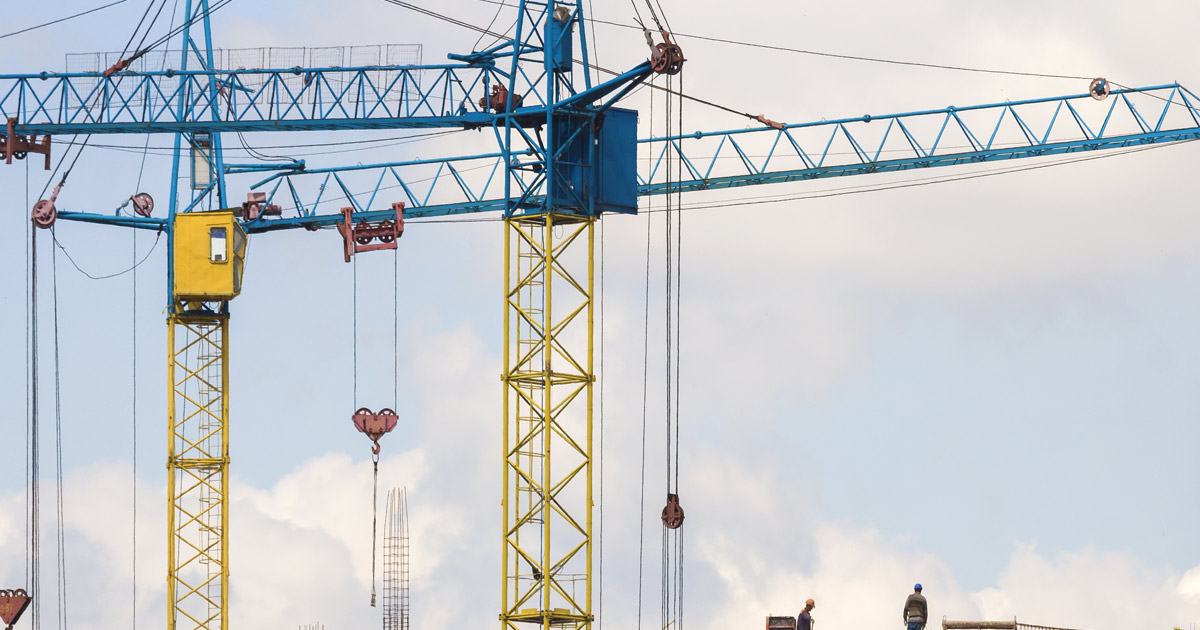Construction cranes are used to lift, lower, and transport objects around the job site. Without them, it would be nearly impossible to build and deconstruct buildings, bridges, and other major structures. The size and weight of this equipment poses a significant risk not only to the crane operators themselves, but also to any workers and pedestrians on site.
According to the Occupational Safety and Health Administration (OSHA) an average of 70 lives are lost every year in crane accidents. That does not include the thousands of workers and bystanders who are injured annually in construction accidents involving cranes. If you are injured in a crane accident at work, your employer’s workers’ compensation policy should cover the expense of your care, as well as any wages lost from work missed as a result of your injuries.
Safety Hazards Vary for Different Types of Cranes
To understand the risks that come with crane use on the construction site, it is helpful to consider the differences between mobile cranes and static cranes. Mobile cranes are designed to travel throughout the job site, transferring items from one location to another.
Static cranes are permanently installed in a single location, and are used to lift and move objects across a set path. While they are efficient, they are not as flexible as mobile cranes regarding the tasks they perform. Static cranes are permanently installed on the construction site.
Within these two categories, there are a wide variety of cranes. Tower cranes are perhaps the most recognizable. These are the cranes you see overhead, adjacent to large multi-level structures. A self-erecting static crane is more lightweight and can be easily erected and dismantled for short-term use.
A crawler crane is attached to a heavy vehicle with treads that are similar to a tank. Because they are able to navigate soft, uneven ground, they are often used at the start of construction projects.
All-terrain cranes are also useful for traveling over rough surfaces. They can also be driver on the road which makes them easy to transport. All-terrain cranes are mounted onto large trucks and can lift a significant amount of weight.
Why Do Crane Accidents Happen?
Based on their size and use, all of these cranes come with their own risks. Here are the most common types of crane accidents:
- Boom collapse
- Contact with power lines
- Dropped loads
- Falls from equipment
- Overturned cranes
- Rigging failures
8 Crane Accident Prevention Tips for a Safer Construction Site
- Check the Weather: Before a lift, check local weather conditions and plan accordingly. Avoid lift operations when conditions exceed permissible wind speeds.
- Use the Right Crane for the Task: As mentioned above, there are several types of cranes for various tasks, heights, and load weights. Never exceed the manufacturer’s limits for the crane in use.
- Inspect the Crane for Damage: Make routine inspections of every crane for excess wear and tear and damaged parts. Ensure every function operates properly and safely.
- Use Consistent Signals: The designated signaler should be the only person giving signals to the crane operator. They should use clear, simple, agreed-upon signals to prevent confusion.
- Clear the Load Lift Area Before Starting: The lift path should be cleared of people and obstructions before starting the lift. Never move a load over workers. When the crane is in motion, walk ahead of the load to warn others to keep clear of the lift path.
- Properly Secure the Sling: Use the appropriate sling for the lift. Slide it onto the hoisting hook and secure it by closing the safety latch. Never attempt to hammer a sling into position.
- Follow Guidelines for Suspending Loads: OSHA permits working gear to be suspended only under very specific conditions. Loads should never be suspended over an entrance or exit. Weight on a suspended load should be “negligible” compared to the lifting capacity of the crane. The crane must be restrained by a trained individual and barricades must be erected around the are to prevent employees from accessing the fall zone.
- Employ Lockout/Tagout Protocols: Proper lockout-tagout procedures should be utilized to protect workers from hazardous energy during crane inspection and repairs. Permanent locking devices prevent accidental engagement of energy sources. Tags warn others to keep valves and circuit-breakers off.
Wind Is An Unseen Threat to Construction Workers and Crane Operators
Of all of the risks facing construction workers utilizing cranes on the job site, the most dangerous hazard is invisible: wind.
Exposure to wind caused nearly one-quarter of all crane accidents over a ten-year-period. A mild wind makes it challenging for a crane operator to maintain a steady load. In windy conditions, they must adjust for swinging the boom and load drift and spin. Unfavorable wind conditions can potentially be a factor in all of the crane accidents listed above.
Proper training to address windy conditions is critical simply because wind is a possibility every day on the job site. In fact, one crane manufacturer produced a 56-page training manual explaining how wind affects crane operations.
I Was Injured in a Crane Accident at Work. Are My Medical Bills Covered?
Most New Jersey workers are entitled to workers’ compensation benefits if they are injured or become ill on the job. While there are some exceptions, you may have a viable claim for benefits to cover your medical costs, a percentage of your lost income, and some other expenses under the law.
Always report a work injury to management as soon as possible. Seek prompt medical attention and contact a workers’ compensation lawyer to initiate a claim. Delays and oversights after a work injury can absolutely impact your chance of collecting workers’ compensation. An attorney’s assistance can make the difference for your crane injury claim.
Burlington County Workers’ Compensation Lawyers at Pietras Saracino Smith & Meeks, LLP, Fight for Injured Employees Across New Jersey
Construction accidents involving cranes and other large equipment are more likely to cause serious injuries. Our experienced Burlington County workers’ compensation lawyers at Pietras Saracino Smith & Meeks, LLP, understand how an unfortunate work injury can impact a person’s life. To schedule your free consultation, call 856-761-3773 or contact the firm online. Located in Cherry Hill, New Jersey, our firm represents clients in and around Camden, Cinnaminson, Maple Shade, Pennsauken, and all of South Jersey.







